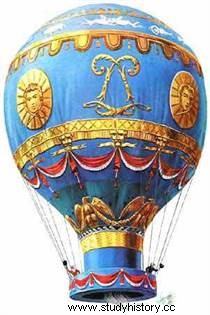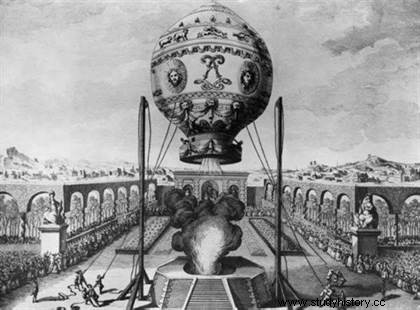 The Montgolfier brothers invented the first hot air balloon. On June 4, 1783, they made history by air in their hot air balloon made of canvas and paper. Three months later, the two brothers presented their balloon to King Louis XVI and Marie-Antoinette:the gondola carried a duck, a rooster and a sheep, thus proving the harmlessness of flight in an atmosphere. In November of the same year, Pilâtre de Rozier made the first aerial journey, over Paris. Nowadays, inflated by gas burners, the hot air balloon is used for sporting and tourist purposes. Every first weekend of June, a myriad of hot air balloons soar proudly into the sky from Annonay in Ardèche, commemorating the first balloon flight.
The Montgolfier brothers invented the first hot air balloon. On June 4, 1783, they made history by air in their hot air balloon made of canvas and paper. Three months later, the two brothers presented their balloon to King Louis XVI and Marie-Antoinette:the gondola carried a duck, a rooster and a sheep, thus proving the harmlessness of flight in an atmosphere. In November of the same year, Pilâtre de Rozier made the first aerial journey, over Paris. Nowadays, inflated by gas burners, the hot air balloon is used for sporting and tourist purposes. Every first weekend of June, a myriad of hot air balloons soar proudly into the sky from Annonay in Ardèche, commemorating the first balloon flight.
The Montgolfier brothers make an old dream come true
Flying is an old human dream that can only be realized if we consider the principle of relative density of bodies discovered by Archimedes in the 3rd century BC.- C. By respecting the rule of the Greek scientist, the flying machine must be lighter than air. It was the Portuguese Bartolomeu de Glismuo who, in 1709, made the first ascent of a model hot-air balloon.
 However, it was not until the year 1783 that the brothers Étienne and Joseph de Montgolfier also discovered the effects of hot air and try the experience of balloon flight. The first test took place on June 4, 1783 in Annonay and its success had a great impact, even at the court of King Louis XVI, thus concretizing the invention of the hot air balloon.
However, it was not until the year 1783 that the brothers Étienne and Joseph de Montgolfier also discovered the effects of hot air and try the experience of balloon flight. The first test took place on June 4, 1783 in Annonay and its success had a great impact, even at the court of King Louis XVI, thus concretizing the invention of the hot air balloon.
On September 19, 1783, the first manned flight took place in Versailles with a crew made up of farmyard animals. A month later, on November 21, 1783, Jean-François Pilâtre de Rozier made the first human flight. Then followed the first hydrogen balloon flight by the physicist Charles, on December 1, 1783.
The Hot Air Balloon, an invention with multiple applications
Rapidly, the crossing of the English Channel in a balloon became the subject of competition, in particular for the two enthusiasts Jean-François Pilâtre de Rozier, who would become the first victim of an aerial accident during the test of a gas balloon, and his rival Jean-Pierre Blanchard who will eventually succeed on January 7, 1785. Emblem of progress, the hot air balloon quickly became popular and a fad, covering many objects:dishes, boxes, fans...
Subsequently, the hot air balloon was briefly used for military purposes during the Revolutionary Wars (Battle of Fleurus in 1794), the Civil War, as well as during the siege of Paris in 1870 (flight of Gambetta).
Nowadays it is the subject of a rather expensive leisure activity, but also useful for aerial photography. Dirigible balloons and aircraft of all kinds will take over with more or less success, in the wake of the path of the air opened by the hot air balloon.
To go further
- The History of Inventions . The World, 2015.
- The Montgolfier Brothers:And their amazing machines . Full Wind, 1982.
